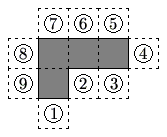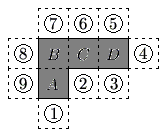Difference between revisions of "2003 AMC 10A Problems/Problem 10"
(added problem and solution) |
(added pic) |
||
| Line 1: | Line 1: | ||
== Problem == | == Problem == | ||
The polygon enclosed by the solid lines in the figure consists of 4 congruent squares joined edge-to-edge. One more congruent square is attached to an edge at one of the nine positions indicated. How many of the nine resulting polygons can be folded to form a cube with one face missing? | The polygon enclosed by the solid lines in the figure consists of 4 congruent squares joined edge-to-edge. One more congruent square is attached to an edge at one of the nine positions indicated. How many of the nine resulting polygons can be folded to form a cube with one face missing? | ||
| + | |||
| + | [[Image:2003amc10a10.gif]] | ||
<math> \mathrm{(A) \ } 2\qquad \mathrm{(B) \ } 3\qquad \mathrm{(C) \ } 4\qquad \mathrm{(D) \ } 5\qquad \mathrm{(E) \ } 6 </math> | <math> \mathrm{(A) \ } 2\qquad \mathrm{(B) \ } 3\qquad \mathrm{(C) \ } 4\qquad \mathrm{(D) \ } 5\qquad \mathrm{(E) \ } 6 </math> | ||
== Solution == | == Solution == | ||
| + | [[Image:2003amc10a10solution.gif]] | ||
| + | |||
Let the squares be labeled <math>A</math>, <math>B</math>, <math>C</math>, and <math>D</math>. | Let the squares be labeled <math>A</math>, <math>B</math>, <math>C</math>, and <math>D</math>. | ||
Revision as of 20:16, 4 November 2006
Problem
The polygon enclosed by the solid lines in the figure consists of 4 congruent squares joined edge-to-edge. One more congruent square is attached to an edge at one of the nine positions indicated. How many of the nine resulting polygons can be folded to form a cube with one face missing?
![]()
Solution
Let the squares be labeled ![]() ,
, ![]() ,
, ![]() , and
, and ![]() .
.
When the polygon is folded, the "right" edge of square ![]() becomes adjacent to the "bottom edge" of square
becomes adjacent to the "bottom edge" of square ![]() , and the "bottom" edge of square
, and the "bottom" edge of square ![]() becomes adjacent to the "bottom" edge of square
becomes adjacent to the "bottom" edge of square ![]() .
.
So, any "new" square that is attached to those edges will prevent the polygon from becoming a cube with one face missing.
Therefore, squares ![]() ,
, ![]() , and
, and ![]() will prevent the polygon from becoming a cube with one face missing.
will prevent the polygon from becoming a cube with one face missing.
Squares ![]() ,
, ![]() ,
, ![]() ,
, ![]() ,
, ![]() , and
, and ![]() will allow the polygon to become a cube with one face missing when folded.
will allow the polygon to become a cube with one face missing when folded.
Thus the answer is ![]() .
.











